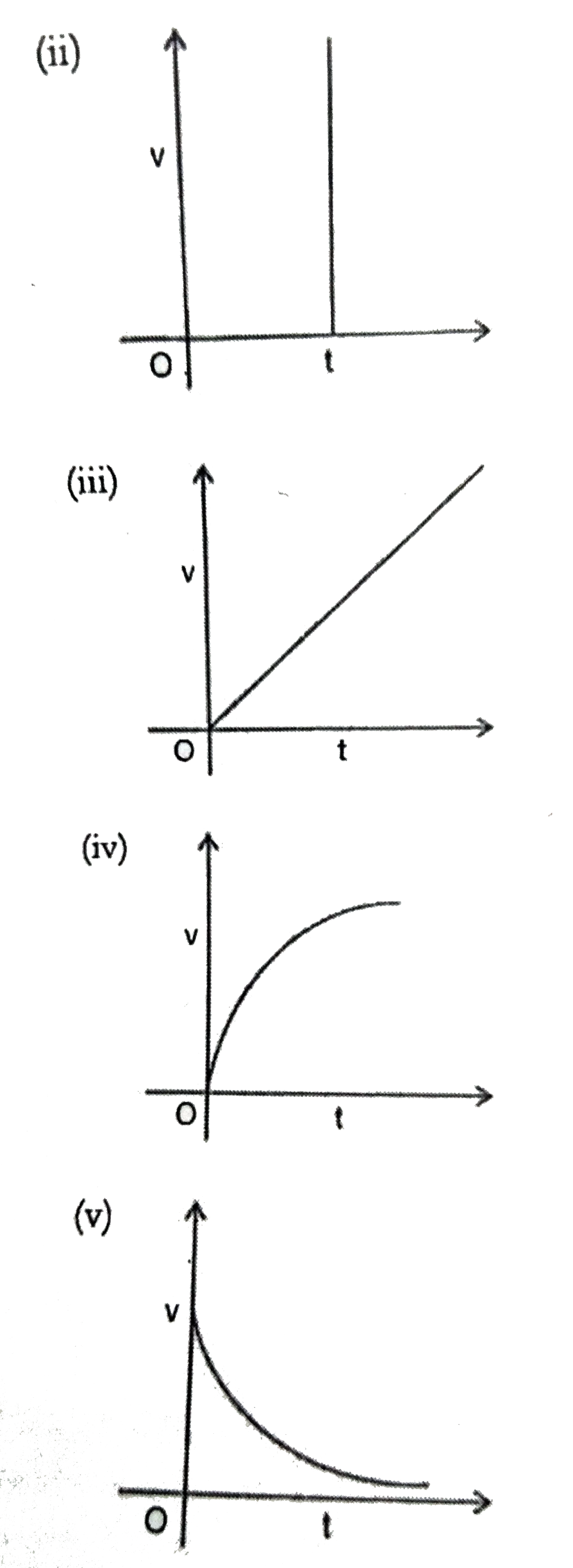Complete Solutions to CONCEPT APPLICATION (Level 2) of chapter KINEMATICS of Class 8 book with complete answers and questions
| Class 8 | PHYSICS |
| Chapter | KINEMATICS |
| PEARSON IIT JEE FOUNDATION | CONCEPT APPLICATION (Level 2) |
| Number Of Questions | 21 |
| Academic Year | 2023-24 |
In the following graphs, the velocity of linearly moving body is against its time of travel. Analyse each of the given graphs and disecus the type of motion of the body


View SolutionIn the following graphs, the velocity of linearly moving body is against its time of travel. Analyse each of the given graphs and disecus the type of motion of the body


View SolutionIn the following graphs, the velocity of linearly moving body is against its time of travel. Analyse each of the given graphs and disecus the type of motion of the body


View SolutionIn the following graphs, the velocity of linearly moving body is against its time of travel. Analyse each of the given graphs and disecus the type of motion of the body


View SolutionIn the following graphs, the velocity of linearly moving body is against its time of travel. Analyse each of the given graphs and disecus the type of motion of the body


View SolutionA bus moving along a straight highway with a speed of 72 km `h^(-1)` is brought to rest within a distance of 50 m. How long does it take for the bus to stop?
View SolutionA train of certain length traveling with a uniform speed of 36 km `h^(-1)` crosses a bridge of 600 m in 80 s. Find the length of the train.
View SolutionThe length of a minure hand of clock is 3 cm. Find the aerage velocity of the tip of the minute hand when it moves during a time interval form `4:00` p.m. to `4:15` p.m.
View SolutionGive examples of variable velocity, when
the magnitude is constant and the direction is changing.
View SolutionGive examples of variable velocity, when
the magnitude is changing and the direction remains the same.
View SolutionGive examles of variable velocity, when
(a) the magnitude is constant and the direction is changing
n (b) the manitude is cahnging and the driection remains the same
(c) both the magnitude and direction are changing
View SolutionThe distance betweenn two place A and B is 180 km by road adn 120 km by air. An aeroplane takes 20 min to go from A to B whereas a deluxe bus strarting at A takes 5h to reach B. Find the average speed and average velocity by both means of transport)
(Ignore the vertical ascent of aeroplane)
View SolutionA car starting from rest and moving with uniform acceleration on a straight road travels for sometime such that the paths described by it in the last second and the penultimate second of its motion are in the ratio `4:3` respectively . Calculate the total time traveled by the body
View SolutionOn a 60 km stretch of road a cyclist travels first 20 km at a uniform speed of 20 km `h^(-1)`. How fast must he travel the remaining distance so that his average speed is 10 km `h^(-1)` for the entire trip.
View SolutionA car starting from rest and moving along a straight path with uniform acceleration covers distances p and q in the first two successive equal intervals of time. Find the ratio of p to q.
View SolutionA bus starts form rest with an acceleration of `5 m s^(-2)` A man who is on a motorcyle, 24 m behind the bust, overtakes, the bus in 2s. If the motorcyclist moves with uniform velocity, find his velocity
View SolutionThe dimensions (measurements) of a hall are 12m, 4 m and 3, respectively. An ant starts at one corner of the hall, travels only along the adgees and reaches a diagonally opposite, corner, taking the shortest possible route. Find the distance travelled by the at t and its magnitude of displacement .
View SolutionA car takes 25 s to stop after the application of brakes. What is the distance traveled by the car if the brakes produce a uniform retardation of 0.4 m `s^(-2)`?
View SolutionA bus starts moving with uniform acceleration from its position of rest. It moves 48 m in 4 s. On applying the brakes, it stops after covering 24 m. Find the deceleration of the bus.
View SolutionA bust traveling along a straight highway covers one third of the total distance between two plces with a velocity `20m km h^(-1)` . The remaining part of the distance was coverd with a velocity of `30 km h^(-1)` for the first half of the remaining time and with velocity `50 km h^(-1)` for the next half on the time. Find the average velocity of the bus for its whole journery.
View SolutionA particle starts from rest and moves with a constant acceleration along a straight path to attain 64 m `s^(-1)` in t s. If at t = (t + 3)s the speed is 76 `ms^(- 1)`, then find the acceleration of the particle and 't'.
View Solution
CONCEPT APPLICATION (Level 2) questions and complete solutions for chapter KINEMATICS of PEARSON IIT JEE FOUNDATION of Class 8
All Exercises from PEARSON IIT JEE FOUNDATION Class 8 PHYSICS KINEMATICS
- CONCEPT APPLICATION (Level 1)
- CONCEPT APPLICATION (Level 1) (Fill in the blanks)
- CONCEPT APPLICATION (Level 1) (Select the correct alternative)
- CONCEPT APPLICATION (Level 1) (true or false)
- CONCEPT APPLICATION (Level 2)
- CONCEPT APPLICATION (Level 3)
- CONCEPT APPLICATION (Level 3) (Application Based Questions )
- CONCEPT APPLICATION (Level 3)(Understanding Based Questions)
- EXAMPLE
- TEST YOUR CONCEPTS (Essay Type Questions)
- TEST YOUR CONCEPTS (Short Answer Type Questions)
- TEST YOUR CONCEPTS (Very Short Answer Type Questions)